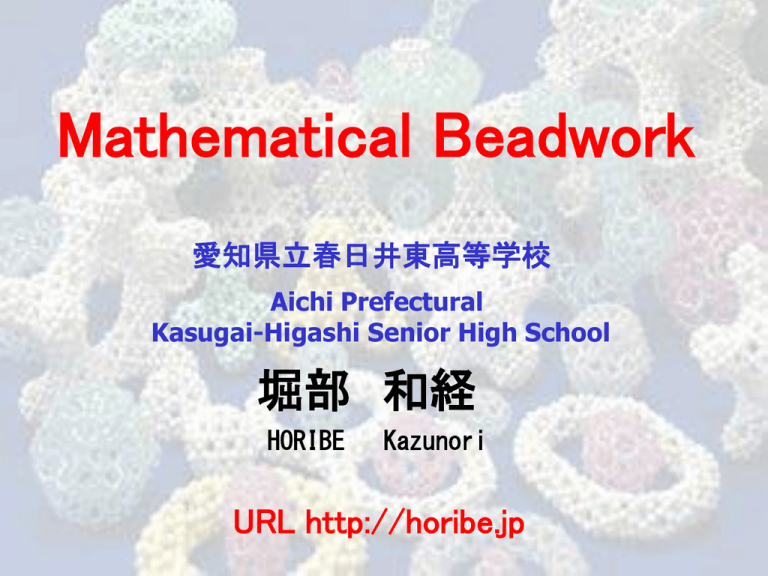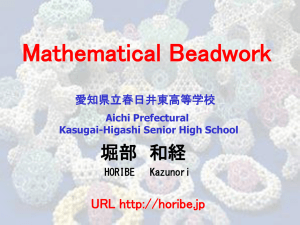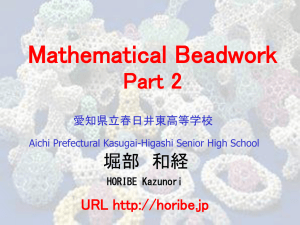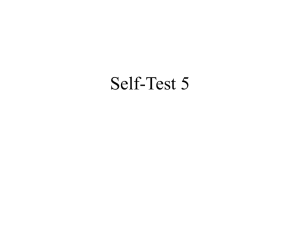Sangaku - HORIBE
advertisement

Mathematical Beadwork 愛知県立春日井東高等学校 Aichi Prefectural Kasugai-Higashi Senior High School 堀部 和経 HORIBE Kazunori URL http://horibe.jp Introduction to Japanese Geometry SANGAKU CAN YOU SOLVE THIS ? MATCH WITS AGAINST JAPANESE GEOMETRY (日本の幾何学と知恵比べ) Scientific American May 1998 The article on Scientific American begins with Of the world’s countless customs and traditions, perhaps none is as elegant, nor as beautiful, as the tradition of sangaku, Japanese temple geometry. 世界中の数え切れない習慣や伝統の中で、日本独自の幾何学 を記した「算額」ほど優雅で美しいものは他に見当たらない。 An illustration on the cover page of Scientific American Sangaku problem It asks for the radius of the n-th largest blue circle in terms of r, the radius of the green circle. Sangaku (mathematical wooden tablet) 1788 in Edo(Tokyo) Prefecture. Note that the red circles are identical, each with the same radius. Hint ? : The radius of the 5-th largest blue r circle is . 95 rn r 2n 1 2 14 r 2 Other problems in sangaku URL http://horibe.jp HD HD Sangaku(replica) W45cm-H30cm 1841 Atsuta Shrine Sangaku(Replica) W240cm-H60cm dated on 1844 Atsuta Shrine in Nagoya City of Aichi Prefecture Sangaku(replica) at Atsuta Shrine 2013 with Sonoda, Ono, and Fukagawa Atsuta Shrine Sangaku W330cm-H132cm 1830 (the genuine tablet) Iwaifudou Temple in Chiba Pref. Steiner Chain HD Iwaifudou Temple in Chiba Pref. Wasan-Juku a private school for mathematics in the city The students were not only Samurai but also children, women and chandlers. W119cm-H37cm 1877 Ishibe Shrine in Fukui Pref. Private mathematics school Studying the method of an equation Studying arithmetic Studying how to do soroban, a Japanese abacus Another Sangaku Problem It asks for the ratio of the radius of the inscribed large sphere in terms of the radius of the small sphare for pentagone. Dodecahedron with regular pentagons Including an inscribed sphere Please take a look at the model in motion. (gif animation) 算法助術 Sanpo-Jojutsu 1841 by Hiromu Hasegawa The collection of mathematical formulae of the Edo period. About 100 formulae are contained. Reprinted edition 2005 The problem appeared as one of the applied problems at the end of the book. 30-ball problem in Sanpo- Jojutsu The description of the question As shown in the figure, the big ball is surrounded by 30 small balls. The small balls touch each other, and are tangent to the surface of the inner big ball as well. If the diameter of Each small ball is 305 sun, what is the diameter of the large ball? The Answer is 682.000 sun. Sun (寸): a unit of the old Japanese length Modeling Cut along an equatorial plane 正10角形 断面図 Regular decagon 正5角形 Regular pentagon R Ratio r 5 additional lines How to solve the problem ( Formula No.3 of Sanpo Jojutsu ) 角中径 1 5 面 2 diagonal 1 5 edge 2 r R 1 5 2r 2 R 1 1 5 r R Therefore 5 r r r r R r r r R Very strange d 2r , D 2 R small d 305 寸 LARGE D 682.000 寸 寸( sun ) ≒ 30.3 mm( 日本) d 9 m 24 cm D 20 m 66 cm They are too big as a model. Nagoya City Science Museum The planetarium dome has a diameter of 35 m. 682 5 2.236068 , 2.236066 305 Actually The large numbers 305 & 682 are chosen. Why such large numbers ? 682 5≒ 305 High accuracy in rational number approximation 682 465,124 , 305 5 2 2 465,125 ( Extension ) Pell's equation x y 5 2 Solution x , y (305, 682) 2 1 Next question How to find 682 ≒ 5 305 Set x 5 1 1 thus x 2 5 2 2 5 2 x 1 2 x 2 2 x 1 1 2 2 2 x 1 1 1 x 2 2 2 1 1 2 x 4 4 1 2 x 4 4 零約術( Reiyaku jutsu ) set : 0 1 1 1 x≒2 2 2 1 1 17 4 4 4 1 4 72 4 4 1 17 4 4 72 682 2 305 305 1 4 0 Notice: We know this problem which was carried in the 1830 book Sanpo-Kisho by Baba Seitoku (1801-1860). Accoding to the book, the problem was written on a mathematical tablet. In the book, Baba recorded thirty-six sangaku collected from shrines in Tokyo. The problem was originally proposed by Ishikawa Nagamasa, a student of the school of Baba Seito (1777-1840), who was Seitoku’s father. It was written on a tablet, which was hung in 1798 in Gyuto Temple Shrine, Tokyo. Therefore, it had already existed as a mathematical problem in 1798. Personal Memorandum 算額(Sangaku) 1798 東京都四谷区牛頭天王社 馬場正督の門人・石川永政 算法奇賞(Sanpo-kishyo)1830 正督の息子・馬場正統 算法助術(Sanpo-jyojutsu)1841 長谷川弘閲 Main Subject Mathematical Beadwork My Work is mathematical work??? or hobby work??? N=6 N=12 N=30 N=90 N=30 N=120 N=270 Semiregular polyhedron N=210 N=120 N=90 N=30 Straight shape Too simple ! Helical shape Y shape Torus shape Other Torus Red coral Tricolor ring Orthogonal coordinate system shape 3D-hashtag character shape 「3D井の字」 Tetrapod shape 3D continuous tetrapod shape Regular dodecahedron shape 作品(15) 作品(16) This model’s description Diameter = 38 mm was the former size of a ping-pong ball. This wooden ball diameter is about 17 mm. 5 ≒2 1 1 4 40 4 38 2 17 17 零約術( reiyaku jutsu ) Diameter = 40 mm is the present size. Mathematical Beadwork model making of 30 ball problem 愛知県立春日井東高等学校 Aichi Prefectural Kasugai-Higashi Senior High School 堀部 和経 HORIBE Kazunori URL http://horibe.jp http://horibe.jp/PDFBOX/Manual_B30.pdf Now, I will show you how to beadwork. Steps 1,2 Steps 3,4 Steps 5,6 Steps 7,8 Steps 9,10 Steps 11,12 Steps 13,14 Steps 15,16 Steps 17,18 URL http://horibe.jp HD Trivia The company name, Nittaku, is not printed on the ball. Because this is a custom-made ball by NIPPON TAKKYU Co.,Ltd. I think that no-logo balls are beautiful. I wish that the balls are former size. My treature No logo ping-pong balls This work made with no logo ping-pong balls was displayed in the lobby of Nittaku Co. Bld. Ballstructure.com WB_MakingB.htm Back to the interrupted place Personal Memorandum Personal Memorandum • • • • • • • Personal Memorandum That’s the point. This is the point I want to emphasize here. Please remember this point. Please pay attention to the following. Let’s turn to the ・・・. Let me see.






